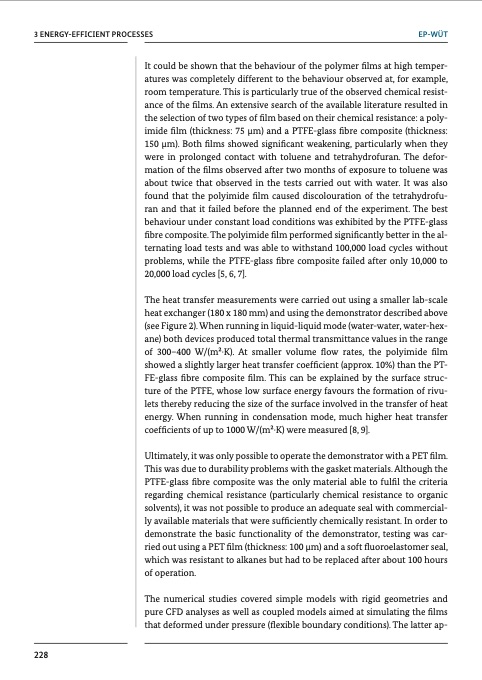
PDF Publication Title:
Text from PDF Page: 231
3 ENERGY-EFFICIENT PROCESSES EP-WÜT It could be shown that the behaviour of the polymer films at high temper- atures was completely different to the behaviour observed at, for example, room temperature. This is particularly true of the observed chemical resist- ance of the films. An extensive search of the available literature resulted in the selection of two types of film based on their chemical resistance: a poly- imide film (thickness: 75 μm) and a PTFE-glass fibre composite (thickness: 150 μm). Both films showed significant weakening, particularly when they were in prolonged contact with toluene and tetrahydrofuran. The defor- mation of the films observed after two months of exposure to toluene was about twice that observed in the tests carried out with water. It was also found that the polyimide film caused discolouration of the tetrahydrofu- ran and that it failed before the planned end of the experiment. The best behaviour under constant load conditions was exhibited by the PTFE-glass fibre composite. The polyimide film performed significantly better in the al- ternating load tests and was able to withstand 100,000 load cycles without problems, while the PTFE-glass fibre composite failed after only 10,000 to 20,000 load cycles [5, 6, 7]. The heat transfer measurements were carried out using a smaller lab-scale heat exchanger (180 x 180 mm) and using the demonstrator described above (see Figure 2). When running in liquid-liquid mode (water-water, water-hex- ane) both devices produced total thermal transmittance values in the range of 300–400 W/(m2·K). At smaller volume flow rates, the polyimide film showed a slightly larger heat transfer coefficient (approx. 10%) than the PT- FE-glass fibre composite film. This can be explained by the surface struc- ture of the PTFE, whose low surface energy favours the formation of rivu- lets thereby reducing the size of the surface involved in the transfer of heat energy. When running in condensation mode, much higher heat transfer coefficients of up to 1000 W/(m2·K) were measured [8, 9]. Ultimately, it was only possible to operate the demonstrator with a PET film. This was due to durability problems with the gasket materials. Although the PTFE-glass fibre composite was the only material able to fulfil the criteria regarding chemical resistance (particularly chemical resistance to organic solvents), it was not possible to produce an adequate seal with commercial- ly available materials that were sufficiently chemically resistant. In order to demonstrate the basic functionality of the demonstrator, testing was car- ried out using a PET film (thickness: 100 μm) and a soft fluoroelastomer seal, which was resistant to alkanes but had to be replaced after about 100 hours of operation. The numerical studies covered simple models with rigid geometries and pure CFD analyses as well as coupled models aimed at simulating the films that deformed under pressure (flexible boundary conditions). The latter ap- 228PDF Image | Chemical Processes and Use of CO2

PDF Search Title:
Chemical Processes and Use of CO2Original File Name Searched:
CO2_Buch_engl.pdfDIY PDF Search: Google It | Yahoo | Bing
NFT (Non Fungible Token): Buy our tech, design, development or system NFT and become part of our tech NFT network... More Info
IT XR Project Redstone NFT Available for Sale: NFT for high tech turbine design with one part 3D printed counter-rotating energy turbine. Be part of the future with this NFT. Can be bought and sold but only one design NFT exists. Royalties go to the developer (Infinity) to keep enhancing design and applications... More Info
Infinity Turbine IT XR Project Redstone Design: NFT for sale... NFT for high tech turbine design with one part 3D printed counter-rotating energy turbine. Includes all rights to this turbine design, including license for Fluid Handling Block I and II for the turbine assembly and housing. The NFT includes the blueprints (cad/cam), revenue streams, and all future development of the IT XR Project Redstone... More Info
Infinity Turbine ROT Radial Outflow Turbine 24 Design and Worldwide Rights: NFT for sale... NFT for the ROT 24 energy turbine. Be part of the future with this NFT. This design can be bought and sold but only one design NFT exists. You may manufacture the unit, or get the revenues from its sale from Infinity Turbine. Royalties go to the developer (Infinity) to keep enhancing design and applications... More Info
Infinity Supercritical CO2 10 Liter Extractor Design and Worldwide Rights: The Infinity Supercritical 10L CO2 extractor is for botanical oil extraction, which is rich in terpenes and can produce shelf ready full spectrum oil. With over 5 years of development, this industry leader mature extractor machine has been sold since 2015 and is part of many profitable businesses. The process can also be used for electrowinning, e-waste recycling, and lithium battery recycling, gold mining electronic wastes, precious metals. CO2 can also be used in a reverse fuel cell with nafion to make a gas-to-liquids fuel, such as methanol, ethanol and butanol or ethylene. Supercritical CO2 has also been used for treating nafion to make it more effective catalyst. This NFT is for the purchase of worldwide rights which includes the design. More Info
NFT (Non Fungible Token): Buy our tech, design, development or system NFT and become part of our tech NFT network... More Info
Infinity Turbine Products: Special for this month, any plans are $10,000 for complete Cad/Cam blueprints. License is for one build. Try before you buy a production license. May pay by Bitcoin or other Crypto. Products Page... More Info
| CONTACT TEL: 608-238-6001 Email: greg@infinityturbine.com | RSS | AMP |